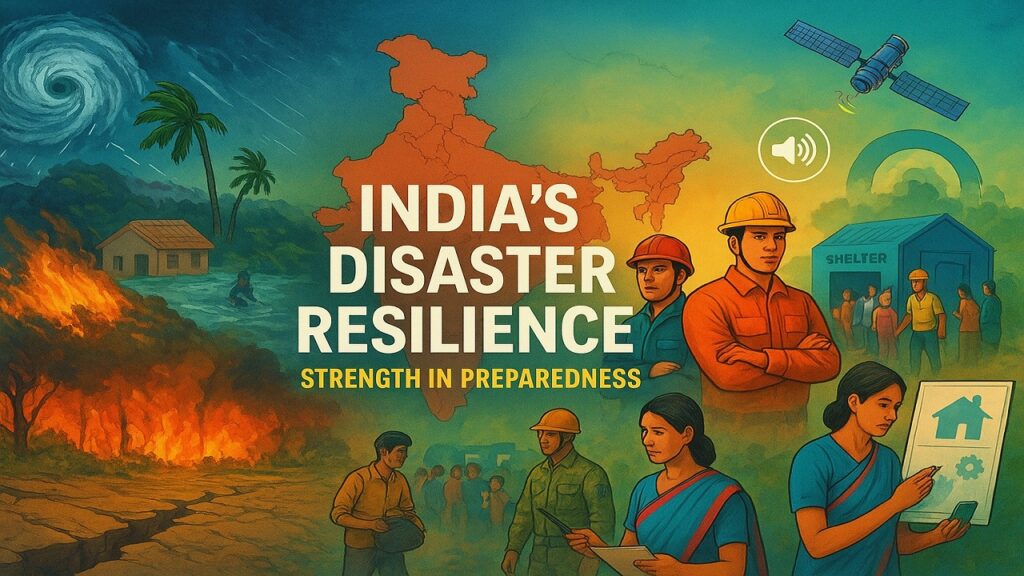India’s Disaster Resilience: Strategy, Implementation, and Future Roadmap
Context:

- Recently, India has experienced a series of natural and manmade disasters, testing its disaster resilience.
- These events highlight the need for a comprehensive, multi-hazard approach to reduce the adverse impacts of disasters.
- Effective disaster resilience ensures communities, individuals, and systems can resist, absorb, adapt, and recover from hazards while maintaining essential functions.
Definition of Disaster Resilience:
- The ability of communities, individuals, and systems to minimize losses and preserve essential functions during disasters.
- It involves a dynamic process: preparedness, response, recovery, and continuous learning from adverse events.
Need for India:
- India is a vast, multi-hazard country prone to heatwaves, extreme rainfall, cyclones, floods, and landslides.
- International coordination is crucial for learning global best practices and sharing India’s expertise.
Institutional Oversight:
- The Ministry of Home Affairs (MHA) and National Disaster Management Authority (NDMA) monitor both pre- and post-disaster phases.
- They follow the Prime Minister’s Ten-Point Agenda on Disaster Risk Reduction (2016) as guiding principles.
India’s Disaster Resilience Framework and Initiatives
1. 15th Finance Commission’s Approach to DRR
- Year: 2021
- Total Fund Allocation: ₹2.28 lakh crore (~$30 billion) over five years.
- Focus: Expanded from post-disaster relief to include:
- Prevention
- Mitigation
- Preparedness
- Capacity building
- Post-disaster reconstruction
Fund Breakdown:
- Pre-disaster (30%):
- Preparedness & Capacity Building – 10%
- Mitigation – 20%
- Post-disaster (70%):
- Response – 40%
- Reconstruction – 30%
Five Priority Areas:
- Evaluate and prioritize India’s multi-hazard challenges.
- Integrate scientific concepts of mitigation and reconstruction into public finance.
- Avoid duplication with existing programs.
- Enhance inter-ministerial, institutional, and Centre-State coordination.
- Establish light-touch regulatory processes.
Implementation:
- Standards and procedures for project design and expenditure established.
- Inter-ministerial and Centre-State appraisal committees oversee hazard- or region-specific projects.
2. Reconstruction and Post-Disaster Response
- First five reconstruction packages approved for Uttarakhand, Himachal Pradesh, Sikkim, Assam, and Kerala.
- Outlay: ₹5,000 crore
- Scientific damage assessments ongoing for extreme precipitation events during the monsoon.
3. Pre-Disaster Preparedness
- Fire Safety Modernisation: ₹5,000 crore allocated.
- Volunteer Networks:
- Apda Mitra and Yuva Apda Mitra, totaling 2.5 lakh volunteers.
- Capacity Building:
- Establish geo-spatial training labs.
- Expand faculty-led action-based research at National Institute of Disaster Management (NIDM).
- Launch 36-stream standard course for mainstreaming disaster preparedness at the panchayat level.
4. Mitigation Initiatives
- Fund Allocation: 20% of pre-disaster funds.
- Projects Approved: ₹10,000 crore (~$1.2 billion) across States.
- Focus: Nature-based, climate-resilient solutions for long-term risk reduction.
Cyclone Mitigation:
- National Cyclone Mitigation Programme (2011–22) – ₹5,000 crore
- Achievements: Early warning systems, cyclone shelters, embankments across 8 coastal States.
NDMA’s Mitigation Priorities:
- Revitalize urban water bodies and green spaces to prevent floods.
- Use remote sensing and automated weather stations for glacial lake monitoring.
- Apply bio-engineering solutions for landslide-prone zones.
- Rejuvenate Brahmaputra’s beels.
- Strengthen forest fire prevention through water body management and fuel evacuation.
5. Early Warning Systems and Community Engagement
- Common Alerting Protocol (CAP): Timely alerts in regional languages.
- Institutional Support:
- 327-member university network
- Training at NDRF Academy, National Fire Service College, and NIDM
- Mock Exercises & School Programs: Promote hazard-specific awareness and safety education.
Conclusion: Way Forward
- International collaboration is vital for knowledge exchange and capacity building.
- India leads initiatives like the Coalition for Disaster Resilient Infrastructure (CDRI) and engages in DRR at G20, SCO, BIMSTEC, and IORA.
- With guidance from public, private, academic, and scientific institutions, India is focusing on innovative, sustainable, nature-based solutions to reduce risks from climate change and multi-hazard events.
Source : The Hindu
